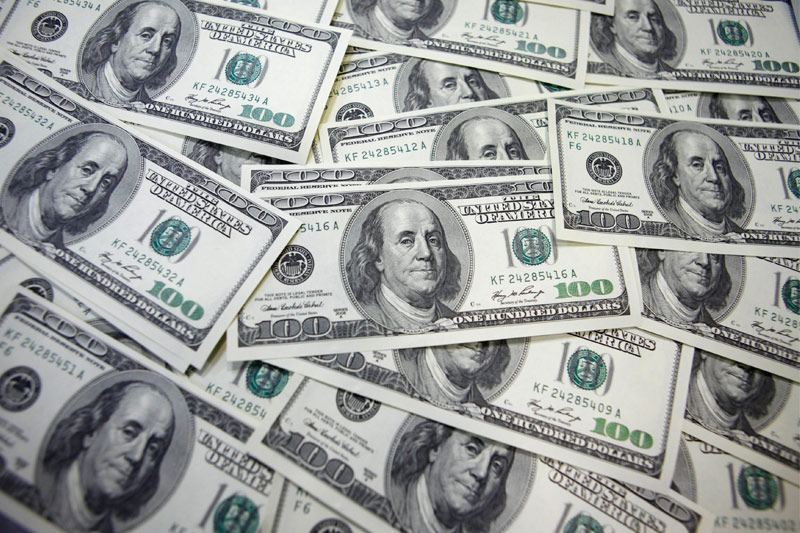Investing.com - The dollar came off highs against the other major currencies on Thursday after data showing that U.S. initial jobless claims rose more-than-expected last week sparked profit taking following the dollar’s gains earlier in the session.
During European afternoon trade, the dollar pulled away from one-week highs against the euro, with EUR/USD down 0.12% to 1.3339, after falling as low as 1.3298.
The Department of Labor said the number of people who filed for unemployment assistance in the U.S. last week rose by 13,000 to a seasonally adjusted 336,000. Analysts had expected U.S. jobless claims to rise by 7,000 to 330,000.
The dollar remained broadly stronger after the minutes of the Federal Reserve’s July meeting indicated that the bank is on track to start unwinding its stimulus program later this year.
However, officials remain divided over the timing of possible reduction, with almost all committee members agreeing that a change in the asset purchase program was not yet appropriate.
The euro briefly touched session highs earlier after data showed that manufacturing activity in the euro zone expanded at the fastest pace in 26 months in August.
The flash euro zone manufacturing purchasing managers’ index rose to 51.3 from a final reading of 50.3 in July. Analysts had expected the index to inch up to 50.8.
The flash euro zone services PMI rose to a 24-month high of 51.0 from 49.8 in July, better than expectations for a reading of 50.2.
The dollar came off three-week highs against the yen, with USD/JPY up 0.82% to 98.50 off session highs of 98.81.
The yen extended losses against the dollar earlier after the upbeat euro zone data bolstered the outlook for the economic recovery in the region, dampening safe haven demand.
The dollar also pared gains against the pound and the Swiss franc, with GBP/USD down 0.44% to 1.5591 and USD/CHF climbing 0.33% to trade at 0.9254.
Elsewhere, the greenback was broadly higher against its Australian, New Zealand and Canadian counterparts, with AUD/USD up 0.43% to 0.9008, NZD/USD losing 0.28% to trade at 0.7826 and USD/CAD advancing 0.30% to 1.0502.
The growth linked Australian dollar was boosted earlier Thursday after economic data out of China eased concerns over a slowdown in the world’s second largest economy.
The preliminary reading of China’s HSBC manufacturing PMI rose to a four-month high of 50.1 in August, up from 47.7 in July. Economists had forecast a reading of 48.3.
In Canada, official data showed that retail sales unexpectedly fell by 0.6% in June, while core retail sales were down 0.8%, confounding expectations for a 0.1% increase.
The dollar index, which tracks the performance of the greenback versus a basket of six other major currencies, was up 0.26% to 81.57.
During European afternoon trade, the dollar pulled away from one-week highs against the euro, with EUR/USD down 0.12% to 1.3339, after falling as low as 1.3298.
The Department of Labor said the number of people who filed for unemployment assistance in the U.S. last week rose by 13,000 to a seasonally adjusted 336,000. Analysts had expected U.S. jobless claims to rise by 7,000 to 330,000.
The dollar remained broadly stronger after the minutes of the Federal Reserve’s July meeting indicated that the bank is on track to start unwinding its stimulus program later this year.
However, officials remain divided over the timing of possible reduction, with almost all committee members agreeing that a change in the asset purchase program was not yet appropriate.
The euro briefly touched session highs earlier after data showed that manufacturing activity in the euro zone expanded at the fastest pace in 26 months in August.
The flash euro zone manufacturing purchasing managers’ index rose to 51.3 from a final reading of 50.3 in July. Analysts had expected the index to inch up to 50.8.
The flash euro zone services PMI rose to a 24-month high of 51.0 from 49.8 in July, better than expectations for a reading of 50.2.
The dollar came off three-week highs against the yen, with USD/JPY up 0.82% to 98.50 off session highs of 98.81.
The yen extended losses against the dollar earlier after the upbeat euro zone data bolstered the outlook for the economic recovery in the region, dampening safe haven demand.
The dollar also pared gains against the pound and the Swiss franc, with GBP/USD down 0.44% to 1.5591 and USD/CHF climbing 0.33% to trade at 0.9254.
Elsewhere, the greenback was broadly higher against its Australian, New Zealand and Canadian counterparts, with AUD/USD up 0.43% to 0.9008, NZD/USD losing 0.28% to trade at 0.7826 and USD/CAD advancing 0.30% to 1.0502.
The growth linked Australian dollar was boosted earlier Thursday after economic data out of China eased concerns over a slowdown in the world’s second largest economy.
The preliminary reading of China’s HSBC manufacturing PMI rose to a four-month high of 50.1 in August, up from 47.7 in July. Economists had forecast a reading of 48.3.
In Canada, official data showed that retail sales unexpectedly fell by 0.6% in June, while core retail sales were down 0.8%, confounding expectations for a 0.1% increase.
The dollar index, which tracks the performance of the greenback versus a basket of six other major currencies, was up 0.26% to 81.57.
